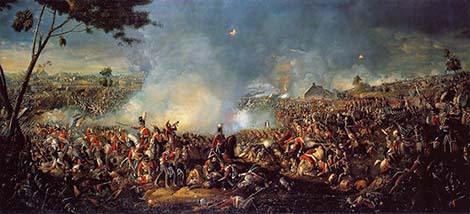 This is an amazing world-class numismatic treasure, combining several numismatic and historic factors. It combines rarity (extremely rare), quality (superb specimen condition), history (struck circa 1806 in the reign of King Maximilian I Joseph of Bavaria during the Napoleonic Wars) and mystique (presented for a service award with an original loop but never worn due to its gem specimen quality).
This is an amazing world-class numismatic treasure, combining several numismatic and historic factors. It combines rarity (extremely rare), quality (superb specimen condition), history (struck circa 1806 in the reign of King Maximilian I Joseph of Bavaria during the Napoleonic Wars) and mystique (presented for a service award with an original loop but never worn due to its gem specimen quality).
 The level of preparation and detail in producing this 200 year old gold specimen medal is amazing. It was struck several times creating a high relief cameo portrait with proof-like mirror surfaces. PCGS acknowledged the superb quality and method of manufacture by authenticating and certifying it as Specimen 65. The gem quality and specimen status reflects its importance as a specially prepared and struck gold medal that is over 200 years old. It is 36mm in width, which is the size of a European Crown, Taler or Dollar. The softness of the gold planchet makes it susceptible to scratches and marks. It is incredible that this breathtaking gem specimen gold medal even exists.
The level of preparation and detail in producing this 200 year old gold specimen medal is amazing. It was struck several times creating a high relief cameo portrait with proof-like mirror surfaces. PCGS acknowledged the superb quality and method of manufacture by authenticating and certifying it as Specimen 65. The gem quality and specimen status reflects its importance as a specially prepared and struck gold medal that is over 200 years old. It is 36mm in width, which is the size of a European Crown, Taler or Dollar. The softness of the gold planchet makes it susceptible to scratches and marks. It is incredible that this breathtaking gem specimen gold medal even exists.
 Although the original loop is attached to this gold medal and the intention was to have it worn on special state occasions, it was obviously never worn and preserved in a coin cabinet throughout 200 years of war, historic events and political upheaval. It is 100% original in its color, patina, toning, cameo portrait, proof-like surfaces and overall original presentation as a specimen strike. One is hard pressed to locate any numismatic gold medal of this size and rarity that approaches 200 years or older in specimen 65, mint state 65 or proof 65, from a major European country such as Germany, England or France. This includes all gold medals in the archives of Heritage, Stack's Bowers and European auction houses that have been certified by either PCGS or NGC in gem condition. It wasn't until the 1860's that a few world mints had the capability to produce and strike gold medals as gem specimens. Even those dated in the 1860's or later are very scarce in gem condition. That is why this gem specimen gold medal circa 1806 is simply amazing.
Although the original loop is attached to this gold medal and the intention was to have it worn on special state occasions, it was obviously never worn and preserved in a coin cabinet throughout 200 years of war, historic events and political upheaval. It is 100% original in its color, patina, toning, cameo portrait, proof-like surfaces and overall original presentation as a specimen strike. One is hard pressed to locate any numismatic gold medal of this size and rarity that approaches 200 years or older in specimen 65, mint state 65 or proof 65, from a major European country such as Germany, England or France. This includes all gold medals in the archives of Heritage, Stack's Bowers and European auction houses that have been certified by either PCGS or NGC in gem condition. It wasn't until the 1860's that a few world mints had the capability to produce and strike gold medals as gem specimens. Even those dated in the 1860's or later are very scarce in gem condition. That is why this gem specimen gold medal circa 1806 is simply amazing.
 This gold medal was designed by Joseph Losch, a German Medalist. He was born in 1770 in Germany and became a famous coin engraver and medalist. Starting in 1802, he engraved at the Bavarian Mint, located in Munich, Germany. The Bavarian Mint, founded in 1158, is considered one of the oldest mints in the world, having existed for over 850 years. In 1808, he was appointed Chief Engraver at the Bavarian Mint and engraved many spectacular coins and medals. This Specimen 65 Gold Medal was struck at the Bavarian Mint circa 1806.
This gold medal was designed by Joseph Losch, a German Medalist. He was born in 1770 in Germany and became a famous coin engraver and medalist. Starting in 1802, he engraved at the Bavarian Mint, located in Munich, Germany. The Bavarian Mint, founded in 1158, is considered one of the oldest mints in the world, having existed for over 850 years. In 1808, he was appointed Chief Engraver at the Bavarian Mint and engraved many spectacular coins and medals. This Specimen 65 Gold Medal was struck at the Bavarian Mint circa 1806.
 For nearly 800 years, the House of Wittelsbach ranked as one of the most powerful and influential of all European dynasties. The Wittelsbachs served as Electors Palatine, Electors of Bavaria, and Counts Palatine. Members of this remarkable family reigned not only in Bavaria, but also in many foreign lands and territories. Many members of the House of Wittelsbach were dukes, kings, and Holy Roman emperors including each of the Bavarian kingdom's six monarchs (Maximilian I Jospeh, Ludwig I, Maximilian II, Ludwig II, Otto, and Ludwig III).
For nearly 800 years, the House of Wittelsbach ranked as one of the most powerful and influential of all European dynasties. The Wittelsbachs served as Electors Palatine, Electors of Bavaria, and Counts Palatine. Members of this remarkable family reigned not only in Bavaria, but also in many foreign lands and territories. Many members of the House of Wittelsbach were dukes, kings, and Holy Roman emperors including each of the Bavarian kingdom's six monarchs (Maximilian I Jospeh, Ludwig I, Maximilian II, Ludwig II, Otto, and Ludwig III).
 Maximilian I Joseph was Duke of Zweibrucken from 1795 to 1799, Prime Elector of Bavaria from 1799 to 1806 and King of Bavaria from 1806 to 1825. He died on October 13, 1825 in Munich, Germany. He will be remembered as one of Napoleon's allies during the famous Napoleonic Wars.
Maximilian I Joseph was Duke of Zweibrucken from 1795 to 1799, Prime Elector of Bavaria from 1799 to 1806 and King of Bavaria from 1806 to 1825. He died on October 13, 1825 in Munich, Germany. He will be remembered as one of Napoleon's allies during the famous Napoleonic Wars.
 One of the most important historical events occurred in 1806 as the Napoleonic Wars were raging throughout Europe, with the destruction of the Holy Roman Empire. Prior to Napoleon destroying the Holy Roman Empire, Bavaria was required to provide an army to fight for the Imperial cause in time of war. After conquering France and part of Europe, Napoleon wanted to use the German States, including Bavaria, as a buffer between France and any invasion by Austria or Prussia.
One of the most important historical events occurred in 1806 as the Napoleonic Wars were raging throughout Europe, with the destruction of the Holy Roman Empire. Prior to Napoleon destroying the Holy Roman Empire, Bavaria was required to provide an army to fight for the Imperial cause in time of war. After conquering France and part of Europe, Napoleon wanted to use the German States, including Bavaria, as a buffer between France and any invasion by Austria or Prussia.
 Napoleon of France was successful in organizing the Confederation of the Rhine. This highlighted the relationship between France and each of the Confederated States of Germany. All of the German States became members under Napoleon except for Prussia, who was an enemy. Bavaria, ruled by Maximilian I Joseph, joined the Confederation of the Rhine in 1806. France, under Napoleon, had 200,000 men and the Kingdom of Bavaria added 30,000 men.
Napoleon of France was successful in organizing the Confederation of the Rhine. This highlighted the relationship between France and each of the Confederated States of Germany. All of the German States became members under Napoleon except for Prussia, who was an enemy. Bavaria, ruled by Maximilian I Joseph, joined the Confederation of the Rhine in 1806. France, under Napoleon, had 200,000 men and the Kingdom of Bavaria added 30,000 men.
 Maximilian I Joseph became King of Bavaria on January 1, 1806, officially changing the Electorate of Bavaria to become the Kingdom of Bavaria. He supported Napoleon in the Napoleonic Wars from 1806 to 1814, when Napoleon was finally defeated. On May 26, 1818 the constitution of the Kingdom of Bavaria was proclaimed. Bavaria was stabilized and was ruled by Maximilian I Joseph until his death in 1825.
Maximilian I Joseph became King of Bavaria on January 1, 1806, officially changing the Electorate of Bavaria to become the Kingdom of Bavaria. He supported Napoleon in the Napoleonic Wars from 1806 to 1814, when Napoleon was finally defeated. On May 26, 1818 the constitution of the Kingdom of Bavaria was proclaimed. Bavaria was stabilized and was ruled by Maximilian I Joseph until his death in 1825.
 This historic and spectacular gold service medal struck circa 1806 when Maximilian I Joseph of Bavaria was Duke, was awarded for "Service to the Duke and Motherland." On January 1, 1806 Maximilian I Joseph became King of Bavaria and the rest is history.
This historic and spectacular gold service medal struck circa 1806 when Maximilian I Joseph of Bavaria was Duke, was awarded for "Service to the Duke and Motherland." On January 1, 1806 Maximilian I Joseph became King of Bavaria and the rest is history.
 Although the official recipient of this historic 200 year old gold medal is unknown, it was struck during the historic Napoleonic Wars circa 1806, presented by the Duke who became King of Bavaria, produced with special manufacturing methods creating a high relief cameo portrait with proof-like surfaces and preserved for over 200 years in gem specimen condition. The reference book of medals by Wittelsbach, which is used by PCGS and NGC to designate medals, lists this medal in silver only.
Although the official recipient of this historic 200 year old gold medal is unknown, it was struck during the historic Napoleonic Wars circa 1806, presented by the Duke who became King of Bavaria, produced with special manufacturing methods creating a high relief cameo portrait with proof-like surfaces and preserved for over 200 years in gem specimen condition. The reference book of medals by Wittelsbach, which is used by PCGS and NGC to designate medals, lists this medal in silver only.
 For comparison purposes, a Maximilian I Joseph Pattern Gold Taler struck in 1818 with an estimated mintage of 100 pieces, sell for $20,000 in EF-AU condition. A NGC PR 62 was recently offered for $30,000. A gem proof is unknown but would be valued at $100,000. This gold taler was struck in 8 Ducat weight, 40mm and commemorated the adoption of the Bavarian Constitution in 1818 when King Maximilian I Joseph ruled Bavaria.
For comparison purposes, a Maximilian I Joseph Pattern Gold Taler struck in 1818 with an estimated mintage of 100 pieces, sell for $20,000 in EF-AU condition. A NGC PR 62 was recently offered for $30,000. A gem proof is unknown but would be valued at $100,000. This gold taler was struck in 8 Ducat weight, 40mm and commemorated the adoption of the Bavarian Constitution in 1818 when King Maximilian I Joseph ruled Bavaria.
 Also for comparison purposes, a similar gold medal struck in 1810 in Frankfurt, Germany, portraying Karl Theodor von Dahlberg, sold in NGC MS 62 for $19,200 in a Heritage Auction. It was also crown size, 40mm and 36.27 grams. It commemorated the Constitution of the Grand Duchy of Frankfurt. If a MS 65 existed it would be $75,000 to $100,000.
Also for comparison purposes, a similar gold medal struck in 1810 in Frankfurt, Germany, portraying Karl Theodor von Dahlberg, sold in NGC MS 62 for $19,200 in a Heritage Auction. It was also crown size, 40mm and 36.27 grams. It commemorated the Constitution of the Grand Duchy of Frankfurt. If a MS 65 existed it would be $75,000 to $100,000.
 This incredible, historic and spectacular gem specimen gold medal, certified by PCGS, belongs in a museum or the finest collection of German gold coins, medals and numismatic rarities.
This incredible, historic and spectacular gem specimen gold medal, certified by PCGS, belongs in a museum or the finest collection of German gold coins, medals and numismatic rarities.
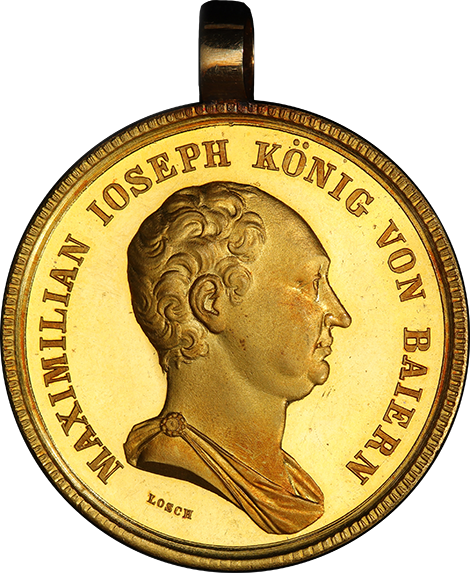
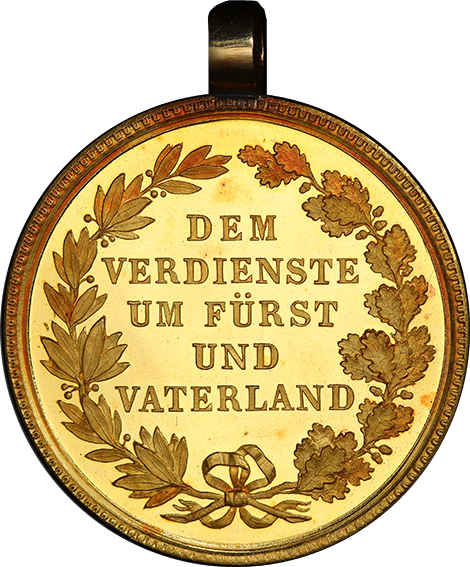
This gold medal has a spectacular high relief portrait:
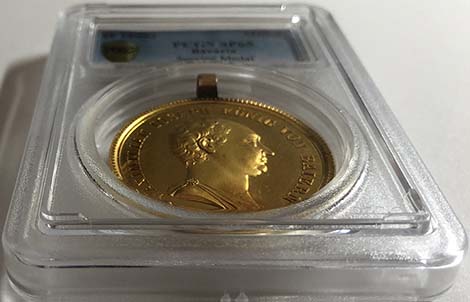
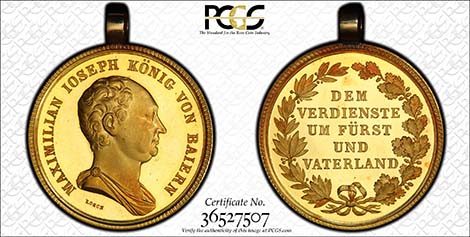
King Maximilian I Joseph:
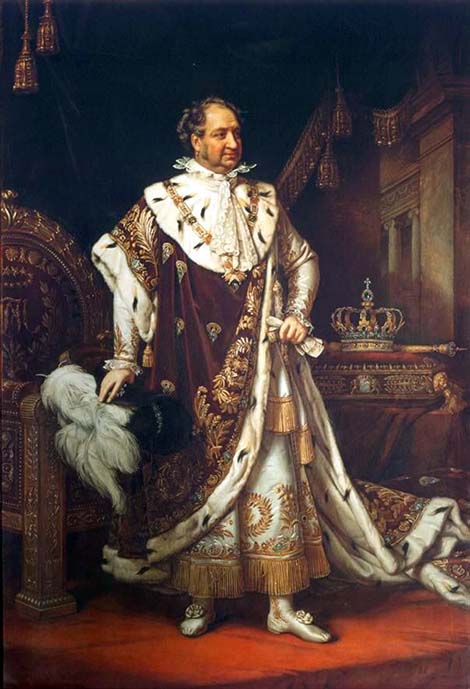
Napoleonic Wars - The Battle of Waterloo 1815:
